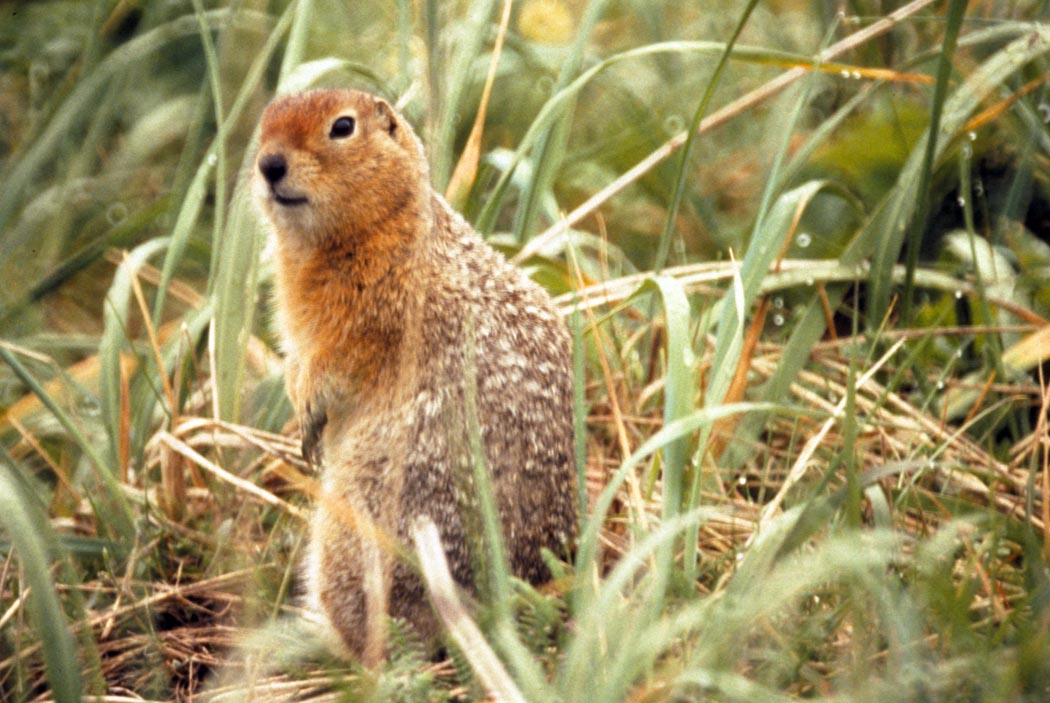- Arctic Ground Squirrel
Taxobox
name = Arctic Ground Squirrel
status = LR/lc
status_system = iucn2.3
status_ref = IUCN2006|assessors=Cook|year=2000|id=20488|title=Spermophilus parryii|downloaded=12 May 2006]

regnum =Animal ia
phylum =Chordata
subphylum =Vertebrata
classis =Mammal ia
ordo =Rodent ia
familia =Sciuridae
genus = "Spermophilus "
species = "S. parryii"
binomial = "Spermophilus parryii"
binomial_authority = Richardson, 1825
subdivision_ranks = Subspecies
subdivision = "S. parryii ablusus" "S. parryii kennicotti" "S. parryii kodiacensis" "S. parryii lyratus" "S. parryii nebulicola" "S. parryii plesius"The Arctic Ground Squirrel ("Spermophilus parryii") ("sicsic", theInuit term) is a species of groundsquirrel native to theArctic .Background
The diurnal Arctic Ground Squirrel lives in
colonies and is the only Arctic animal that hibernates. In the spring and summer it forages fortundra plant s,seed s andfruit to increase body fat for its winter hibernation. By late summer it begins to store food in its burrow so that in the spring it will have edible food until the new vegetation has grown. The burrows are lined withlichen s, leaves andMuskox hair. It is prey to theArctic Fox , theGrizzly Bear andeagle s.During hibernation, its brain and core temperature can drop to just above freezing and its heartbeat drops. Peripheral, colonic, and blood temperatures become subzero by means of
supercooling . Body temperatures drop as low as -2.9°C (average -2°C). [ [http://www.ucalgary.ca/~kmuldrew/cryo_course/cryo_chap12_1.html Muldrew, K., University of Calgary, Feb. 26, 1999] ]Geographic range
The Arctic Ground Squirrel can be found in regions of Northern
Canada ranging from theArctic Circle down to the southern border of theNorthwest Territories , as well asAlaska andSiberia .Habitat
The Arctic Ground Squirrel inhabits dry Arctic
tundra and open meadows in the most southern habitats of this species.Physical description
The Arctic Ground Squirrel has a beige and tan coat with a white-spotted back. This squirrel has a short face, small ears, a dark tail and white markings around its eyes. The average length of an Arctic Ground Squirrel is approximately 39cm, and the average mass 750g (26.4 oz), however, males generally are around 100g heavier than females.
Reproduction
"Spermophilus parryii" live in colonies dominated by one male. Mating occurs in mid May after winter hibernation.
Gestation is approximately 25 days, and results in a litter of 5 to 10, 10g hairless pups. After 6 weeks the pups are weaned and this is followed by rapid growth to prepare for the upcoming winter.Behaviour
The Arctic Ground Squirrel
hibernate s over winter from early September to late April, at which time it can reduce its body temperatures from 37 degrees Celsius to as little as -3 degrees Celsius. In the warmer months the squirrel is active during the day time.Communication between squirrels is done through both vocal and physical means.
Food habits
This squirrel feeds on grasses, sedges, mushrooms, bog rushes, bilberries, willows, roots, stalks, leaves, flowers, and seeds, but can adapt to other foods when necessary. Sometimes this squirrel carries food back to its den within its cheeks.
References
* Brensike, J. 2000. [http://animaldiversity.ummz.umich.edu/site/accounts/information/Spermophilus_parryii.html "Spermophilus parryii"] (On-line), Animal Diversity Web. Accessed April 10, 2007.
Wikimedia Foundation. 2010.
